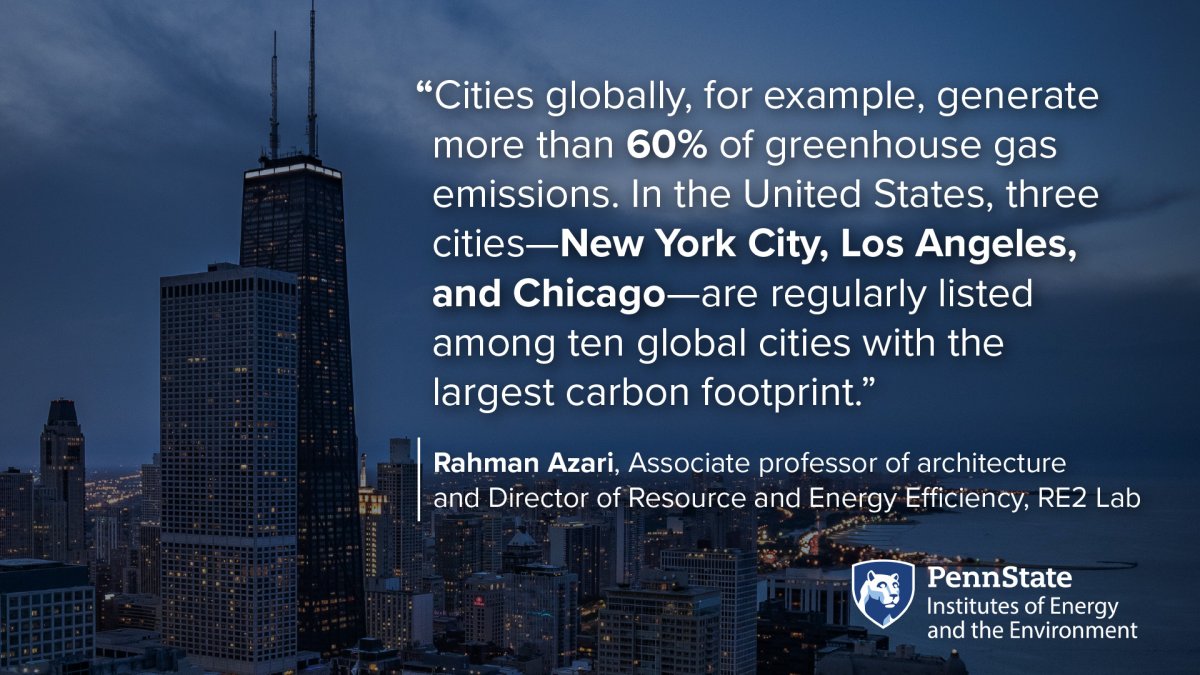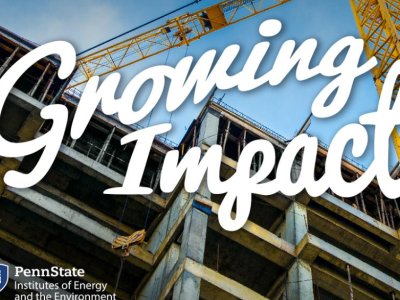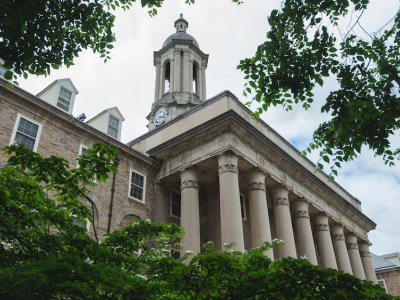11-minute listen | 8-minute read
Every material that makes up a building, be it steel, concrete, wood, or plastic, has a greenhouse gas emission associated with it. This is called embodied carbon, and calculating the amount of GHG for one building is achievable. However, calculating that number for an entire city is still a challenge. To assist policymakers to better manage their city's carbon emissions, a team of researchers is developing a methodology to calculate embodied carbon for an entire city.
Transcript
INTRO: Cities globally generate more than 60 percent of the GHG emissions. In the United States, New York City, Los Angeles, and Chicago, are regularly listed among ten global cities with the largest carbon footprint.
HOST: Welcome to Growing Impact, a podcast by the Institutes of Energy and the Environment at Penn State. Growing Impact explores cutting-edge projects of researchers and scientists who are solving some of the world’s most challenging energy and environmental issues. Each project has been funded through an impactful seed grant program that’s facilitated through IEE. I’m your host, Kevin Sliman.
HOST: Embodied carbon refers to the greenhouse gases related to the materials that make up buildings. The global emissions of greenhouse gases from embodied carbon are significant, resulting in a major impact on the climate. Embodied carbon includes when a building is being constructed, like when the concrete is being manufactured, or the steel beams are being transported to the job site. It also includes maintenance and upkeep of the building. Embodied carbon even includes the demolition and disposal of materials when a building is torn down. That’s the lifecycle of embodied carbon for a building. And generally, we’ve gotten pretty good at calculating the amount of embodied carbon for one building. But what about an entire city? How do we calculate embodied carbon for a city like New York City that matures and grows and rebuilds decade after decade? A team of researchers at Penn State is exploring how to effectively calculate this number in hopes that their methodology can help policymakers better manage the carbon that their cities emit.

HOST: I'd like to welcome Rahman Azari to Growing Impact. Thank you so much for being here, Rahman.
Rahman Azari (RA): Thank you very much for having me.
HOST: Could you please introduce yourself and share a little bit about your research?
RA: Thanks Kevin. I’m Rahman Azari. I’m an Associate Professor of Architecture and a co-funded faculty with the Institutes of Energy and the Environment at Penn State. I also run the Resource and Energy Efficiency (RE2). My research focuses on measuring and mitigating the carbon emissions caused by built environments. A main area of research in the RE2 lab focuses on estimating the embodied carbon and other life cycle environmental impacts of buildings and cities and identify ways to mitigate it. Our objective is to do research to help achieve net-zero emission status in the building sector by 2050.

HOST: Could you explain to us a little bit about urban embodied carbon. What is it? Then maybe we can go into why it's so important that we understand urban embodied carbon.
RA: Embodied carbon is about all construction-related greenhouse gas emissions released during the complete life cycle of a building from raw material extraction through manufacturing and installation of building materials, to maintenance and demolition of the building in the future. In this entire process, greenhouse gas emissions are released that are quantified and aggregated into their equivalent carbon dioxide. That is called embodied carbon. In our project, which is an interdisciplinary collaborative grant with my co-PIs, Professors Lisa Iulo, Mehrdad Mahdavi, and Mostafa Sabbagh, we aim to develop methodologies to estimate embodied carbon at the scale of city. The reason we are doing this research is because at the scale of one building we know how to measure embodied carbon but the methodologies to assess embodied carbon at the scale of city are still not sophisticated enough. Cities generate more than 60% of greenhouse gas emissions. In the United States, New York city, Los Angeles, and Chicago, are regularly listed among 10 global cities with the largest carbon footprint. Also the urban population is growing worldwide and it is estimated that the US urban population will grow to 89% by the mid-century. That translates into more GHG emissions as we need to construct or renovate more buildings, especially that some of the materials we use in buildings such as concrete and metals are energy- and carbon intensive. Concrete and metals contribute 11% to global emissions. So, despite the significance of construction in cities, we have limited understanding of urban embodied carbon and how it is driven by various factors including zoning policies. The challenge is that we don’t have enough public data needed for estimation of embodied carbon at the large scale.
HOST: What's the goal of the project?
RA: The goal of the project to develop methods to use existing data and tools and create a reliable estimation of embodied carbon for cities. We also aim to identify the factors that drive construction-related greenhouse gas emissions in cities and study their relationships. Ultimately, we hope to generate knowledge that would help policymakers take actions to limit building carbon emissions in cities. To achieve our objectives in this research, we will model the embodied carbon of a sample of building reference models representing different building types, and use those data to estimate embodied carbon of a certain city based on its market share of building reference models. For example, we model the embodied carbon of the reference model for single-family detached housing and multiply it by its market share in a city like New York City. Then, we will complement and reconcile this bottom-up approach with a top-down approach that uses the aggregate flows of construction materials for embodied carbon assessment.

HOST: In your abstract, you state, “Studies suggest that compact cities and high-rise construction lead to more environmentally sustainable built environments through concentrated infrastructure, reduced travel distances, reduced energy use, and high-rise buildings, due to their unique building form and occupancy characteristics. Yet, little is known about the effects of urban densification on embodied carbon.” Could you talk a little bit about that and discuss that idea of why so little is known?
RA: As you know, the growth of urban population in the 20-century led to growth of cities. Urban sprawl is a product of this growth and has led to the increased infrastructure costs, greater impacts on the environment, and more energy consumption. Compact developments have the potential to address urban sprawl in cities but we need to understand the synergies and tradeoffs including embodied carbon implications of densification in cities because densification translates into more construction of buildings and infrastructure to more carbon emissions. Densification also could lead to more urban heat islands. So we need to have a more holistic understanding of the effects of zoning policies on the environment.
HOST: You also mentioned policies. Are you comfortable discussing a little bit about that? I'd be interested to learn how policies come into play in this area.
RA: Countries such as Sweden, Denmark and Finland have established policies and building codes to report and limit embodied carbon of buildings. In these countries, not only energy use of new buildings but also their embodied carbon is estimated, reported, and regulated. In Vancouver and Toronto in Canada, they too are establishing requirements for buildings to limit their embodied carbon. So, it is important that the building decarbonization policies target two types of carbon emissions caused by buildings; carbon emissions caused because of energy consumption and embodied carbon which is caused by building construction.
HOST: Does this project touch on policy at all? Or is it more looking at collecting the data from the actual buildings and the cities?
RA: In this specific project, we do not study the policies but we hope to generate knowledge that would help develop more ambitious policies to limit carbon emissions of buildings. Our project will inform mitigation strategies that could help limit embodied carbon in cities.
HOST: As the data on urban embodied carbon is collected, what could be steps, or some steps, to help decrease greenhouse gas emissions from buildings? We discussed a little bit about policies already. I don't know if there's other things you might want to mention or discuss at this point.
RA: A strategy that is recommended to limit embodied carbon is reduce, reuse, sequester. In other words, we need to reduce material consumption in buildings, and reuse and renovate the existing buildings to the extent we can. Low-embodied carbon material alternatives or materials with carbon sequestration capability such as timber can also significantly reduce embodied carbon. At the scale of city, we need to pursue more effective zoning policies that are sensitive to embodied carbon.
HOST: Are there any results or updates that have started to develop with the project at this point?
RA: We are doing a comprehensive survey of literature in the field of embodied carbon to identify the gaps in data and methodologies. We have also collected data on the market share of building construction and are currently modeling reference building models to represent buildings of various types. As an update, I’d like to share that we have recently received a research grant from the Council on Tall Buildings and Urban Habitat to study urban embodied carbon and its tradeoffs with operational carbon in Manhattan. I consider this grant as an extension of the IEE grant for which I’m grateful and I hope that we would be able to collect more data for the next steps of our research.
HOST: Rahman, thank you.
RA: Thank you very much Kevin for this opportunity. I’d like to also thank my collaborators in this project, Professors Iulo, Mahdavi, and Sabbagh.
HOST: This has been season 3, episode 10 of Growing Impact. To read the transcript from this episode and to learn more about Rahman and his research team, find previous podcast episodes, see related graphics, and much, much more, visit iee.psu.edu/podcast. Thanks for listening.











